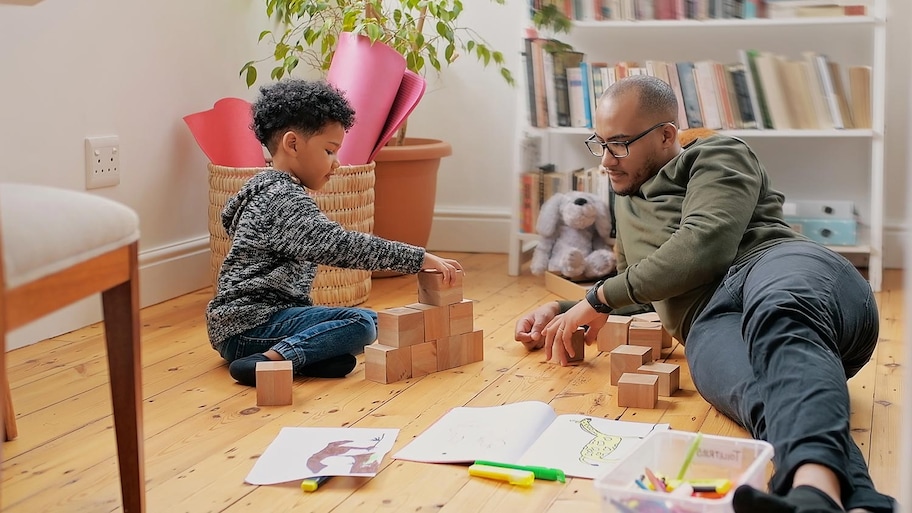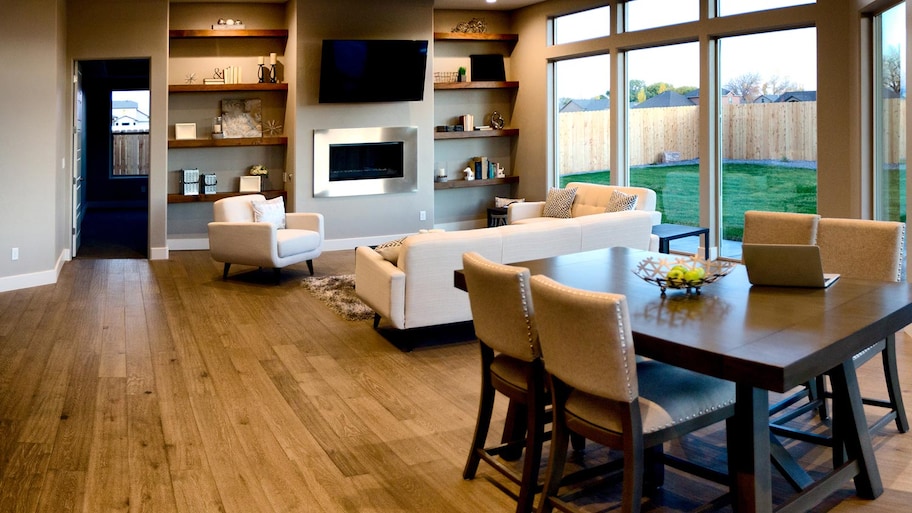How to Choose Hardwood Flooring in 7 Simple Steps
Spoiler alert: There’s more to decide than just oak or ash


Honestly, figuring out what type of flooring you want can be difficult enough, so once you decide on hardwood, you might think the hard work is over. In reality, the decisions have just begun. Fortunately, with a little bit of legwork and research ahead of time (which you’re already doing), choosing hardwood flooring doesn’t have to be as difficult as felling a tree. Explore our seven tips on how to choose hardwood flooring so you can perfectly set your home’s scene for years to come.
1. Choose—Carefully—Which Rooms Are Right for Hardwood
Hardwood is an excellent floor choice for many reasons: its stately appearance, its relatively simple maintenance, and its durability. It is not, however, a good choice for rooms that see a lot of moisture. (And if you’ve ever seen a log rotting in a damp thicket, you know why.)
Hardwood, like any wood, is vulnerable to water damage. In kitchens and bathrooms, for example, where moisture is high and spills happen, liquids can soak into natural wood floors and cause damage and discoloration. This is why the first step in choosing hardwood floors is choosing where in your home they’ll live. We suggest you keep them in the living room or the bedroom.
2. Choose Between Solid and Engineered Hardwood

Solid hardwood is exactly what it sounds like: solid planks of natural wood in the species you choose. However, wood does have a tendency to shapeshift over time, swelling and shrinking depending on factors like humidity and temperature. Engineered hardwood aims to solve these problems by offering a more stable option: a thin upper layer of hardwood bonded to sturdier materials below.
Flooring installers can glue your engineered hardwood directly onto concrete subfloors. This may make for an easier installation if the traditional hardwood installation process (which involves installing a layer or two of plywood over the subfloor) might change the way your doors work or reduce the overall ceiling height. On the other hand, engineered hardwood’s upper layer may be so thin that it makes refinishing the floor, which most hardwood floors do require every few years, impossible. Choosing a higher-quality (and, yes, more expensive) engineered hardwood can help circumvent that problem.
3. Choose Between Prefinished and Unfinished

Prefinished hardwood, as its name suggests, is already finished and won’t require an additional step after installation. On the flip side, your flooring pros will have to finish unfinished hardwood flooring on-site after they install it.
With prefinished hardwood, you know exactly what the color will look like ahead of time, and you don’t have to worry about potential stains, spills, or unevenness that might occur if you finish raw hardwood after a pro installs it in your home. However, site-finish hardwood allows for greater customization when it comes to finishing choices, which can subtly change the color and shine level of the finished product. And because it’s all stained in place, site-finish hardwood floors can sometimes be smoother than their prefinished counterparts.
4. Choose a Species of Wood
Now for the fun part: What kind of wood do you want?
While color is definitely a part of the hardwood species decision, the question of how to choose a hardwood floor color is more like a delicate dance between wood species and finish. An oak hardwood floor, for example, could range from light blonde down into a deep, rich butterscotch, depending on how the manufacturer or pro finishes it.
That said, there are certain attributes, including color, that make various hardwood species attractive to homeowners. For example:
Oak is easily one of the most popular choices for hardwood flooring, thanks to its durability and availability.
Walnut is slightly softer than oak, which means it may be a bit more susceptible to scuffs and scratches. However, it also offers a rich, dark shade and beautiful grain.
Ash is another popular option that leans toward the lighter side, with some finishes making the floor appear almost white.
Cherry creates a strong design choice and aesthetic with its characteristic reddish hues and tendency toward a bright shine.
Maple is another durable option that can stand up to high-traffic areas in your home.
Hickory is one of the hardest woods available, and it’s also one of the most flexible in terms of holding onto stain and shine, making it a great choice for many applications.
5. Choose the Finish Itself
If you’ve chosen site-finish or unfinished hardwood, you’ll also need to make some decisions about how to finish the floor. You can choose from a wide range of finishes, some of which may include staining, which will give additional color tones to your hardwood floors. Hardwood floors can be stained if you want, but they must be sealed to make them more water-resistant and durable. This is a tricky job that’s best left up to a professional contractor, like your local wood floor installer.
6. Choose the Grain Pattern

Thought you were done making decisions about the wood itself? Think again. Along with species and finish type, you’ll also be able to choose from three common grain types: plain-sawn, rift-sawn, and quarter-sawn.
Plain-sawn is the most common type, with its classic pointed patterns, known as cathedrals. Rift-sawn wood, on the other hand, offers a long, even grain with no cathedrals, and it’s often one of the most expensive grain patterns to purchase. Finally, quarter-sawn hardwood is characterized by irregular, three-dimensional-looking speckle patterns that make its grain pop.
7. Choose Plank Width
After you’ve made all these other decisions, you get to choose the width of the hardwood planks you’ll install. There’s a big visual difference between narrow planks (often 2 to 3 inches wide) and broad ones (which can be as much as 6 or 7 inches wide). Another factor to keep in mind: The broader the planks, the more expensive they’ll be. However, if you purchase thinner planks, you’ll need to purchase more of them to cover the same surface area.
Frequently Asked Questions
Along with the factors above, hardwood grading is also worth considering, especially if you’re hoping to protect your investment and keep the floors for a long time. Prime-grade or AB-grade hardwood flooring is the highest quality level available, and it indicates even coloring and a lack of irregularities or natural defects.
While many hardwood floors can last decades with proper maintenance, choosing a harder wood type, like hickory, can help extend the life span of your hardwood floors and reduce the amount of maintenance needed to keep them looking new and shiny. Softer hardwoods, like walnut, may not last quite as long as other types.

